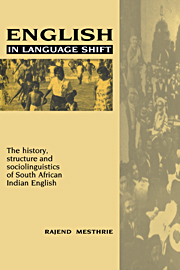 English in Language Shift
English in Language Shift Book contents
- Frontmatter
- Contents
- List of figures and maps
- List of tables
- Preface
- Acknowledgements
- List of abbreviations
- 1 Historical background: the shaping of a New English
- 2 Variation in SAIE: a first glimpse
- 3 Syntactic variation: the relative clause
- 4 Word-order principles
- 5 Non-syntactic variation
- 6 Perspectives from second-language acquisition
- 7 Perspectives from pidgin and creole studies
- Appendix A Comparison between SAIE sample and census data for Indians in Natal
- Appendix B Types of relative clauses used by individual speakers
- Appendix C Rank orders for relative clauses, topics and morphology
- Notes
- Sources and references
- Index
6 - Perspectives from second-language acquisition
Published online by Cambridge University Press: 03 December 2009
- Frontmatter
- Contents
- List of figures and maps
- List of tables
- Preface
- Acknowledgements
- List of abbreviations
- 1 Historical background: the shaping of a New English
- 2 Variation in SAIE: a first glimpse
- 3 Syntactic variation: the relative clause
- 4 Word-order principles
- 5 Non-syntactic variation
- 6 Perspectives from second-language acquisition
- 7 Perspectives from pidgin and creole studies
- Appendix A Comparison between SAIE sample and census data for Indians in Natal
- Appendix B Types of relative clauses used by individual speakers
- Appendix C Rank orders for relative clauses, topics and morphology
- Notes
- Sources and references
- Index
Summary
Introduction
My aim in the final two chapters is to develop two perspectives which will assist in an understanding of many of the characteristics of SAIE. The dialect will be viewed not as a reified finished product, but as an evolving dynamic system. This chapter will examine the nature of second-language acquisition, while the next will explore the SAIE continuum in terms of notions fruitfully developed within the field of pidgin and Creole studies. The two views overlap to some extent, and the applicability of models constructed within creolistics is still a live issue in second-language acquisition (SLA) studies.
The view from language acquisition
We will be examining four themes within the field of second-language acquisition that have particular relevance to the development of SAIE: (a) transfer, (b) universals, (c) strategies of second-language learning, (d) parameter setting.
Recent linguistic studies have emphasised that the acquisition of a second language is not the piecemeal hit-or-miss affair that it often appears to be. Learners seem to go through stages in acquiring the rules of the target language. Learning a new language (especially in natural settings outside the classroom) is not done through imitations of surface structures alone, but through deducing (sometimes incorrectly) the rules that underlie the output. Many errors made by the adult language learner are indications of this process of deduction or hypothesis formation: errors may be – paradoxically – evidence of learning.
There are significant similarities between second-language acquisition and the way a first language is learned by children. Like adults learning a second language, children making deductions about the rules of the target language, often overgeneralise some of them (resulting in forms like corned, doed).
Information
- Type
- Chapter
- Information
- English in Language ShiftThe History, Structure and Sociolinguistics of South African Indian English, pp. 152 - 182Publisher: Cambridge University PressPrint publication year: 1993